
I once owned a large, heavy and expensive CD player, but I was never 100% satisfied with it. A suspicion that the sound was not completely transparent grew stronger and stronger, and I finally sold it. Since then I have been looking for second hand "Best Buys". I`ve tried NADs, Pioneers, Marantz’s etc., but it was an old CD player from Philips, the CD 615, that finally opened my ears. I got it for free. To check that it was functional, I loaded the tray with a Morten Abel CD and headed for the kitchen, but I stopped in my tracks in amazement as the sound streamed out of the loudspeakers. For the first time I heard a CD player reproducing Morten Abel`s music in a manner that I no longer felt the urge to complain about the recording quality.
I had never owned a Philips CD player before. I had no idea if they were any good? For many years the Japanese brands had been better at promoting themselves, and they won over the customers. This experience made me start investigating. Virtually all HiFi magazines these days have a "vintage column”, and there has been much information about "classic CD players” in general, and Philips in particular. I scrambled for such articles and read them over again, and I discovered that the internet in particular is full of information about these classics. There seems to be many who seriously claim that the Philips transports (CDM series) and DACs (TDA 1540 series) are the best ones ever. The CDM transports are close to everlasting, and Svein Ones (my service technician in Bergen) told me that he has never come across a single failed DAC. I therefore feel confident that I can enjoy CD playback for a long time still, even if traditional CD players are barely being produced anymore, and certainly not by Philips (I have checked their home page). You are therefore simply forced to buy second hand, or “second hand new", like I have done. CD discs, however, are still being produced by the truckload!
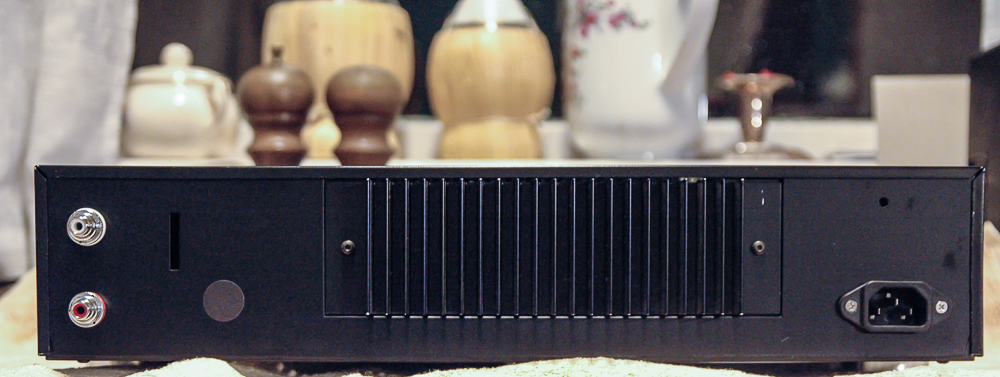
Take a look at the CD 304’s back panel: It does not get any simpler than this. No digital output. But why would you want that when the onboard DAC is world class?
Rektangel AS
More background: Magnulf Rise, the owner of Rektangel AS, was kind enough to send me two refurbished and carefully modified Philips CD players for evaluation. Magnulf is an engineer who established the small company Rektangel AS in Ålesund, in cooperation with BEBOP hifi in Oslo, after his main carrier retirement. Magnulf came into contact with my writer colleague Arve Åheim at the HiFi Messen audio show in Horten, and Arve has already reviewed several products from Rektangel / BEBOP. But when Magnulf asked Arve if he wanted to review these classic CD players, Arve said: “Thank you, but no thanks”. He already had too many products to review. Instead he pointed at me, knowing that I had recently started studying about older CD players.
Technical content of Philips CD 304 and 304 Mk II
I didn`t refuse. I googled CD 304 (from 1984) and quickly learned that this was one of the classics from Philips, one of the most sought after players in the second hand market. Hardly surprising when you consider the 7 kg weight, and the cast iron enclosure. I first received the MK II model, which was the first player with the famous TDA 1541 DAC, 16 bit, which is regarded as THE classic DAC if ever there was one, and which fetches good prices on the market even when sold as an electronic part! I quickly noticed that this player sounded even better than my own slightly newer, but considerably more plasticky CD 615 at a lightweight 3.5 kg (this model has a TDA 1543 DAC which is considered a miniaturisation of the 1541). So, all of a sudden the CD 304 Mk II turned out to be the winner, even if my trusty CD 615 already had beaten everything else that I compared it to.
However, I didn`t immediately consider purchase since the price would be around 10,000 NOK. The next step in my story is to explain the term “second hand new”: The classic CD players are bought from the second hand market, taken apart, greased up, and extensively upgraded. The electrolytic capacitors are replaced, since the old ones dry up and loose capacity with age. Soldering points (e.g. in the power supply) are resoldered, lots of capacitors are paralleled with expensive film capacitors. And, take note, the oversampling is removed. More about this below.
A bit later Rectangle AS also sent me the original CD 304 (Mk 0), so at this point things started to get REALLY interesting. This is the last Philips CD-player with the original 14-bit DAC from Philips, the TDA 1540; and there is even two of them onboard. I connected it to my setup, and quickly concluded that this one also easily bettered my own CD 615, so there were no surprises yet.
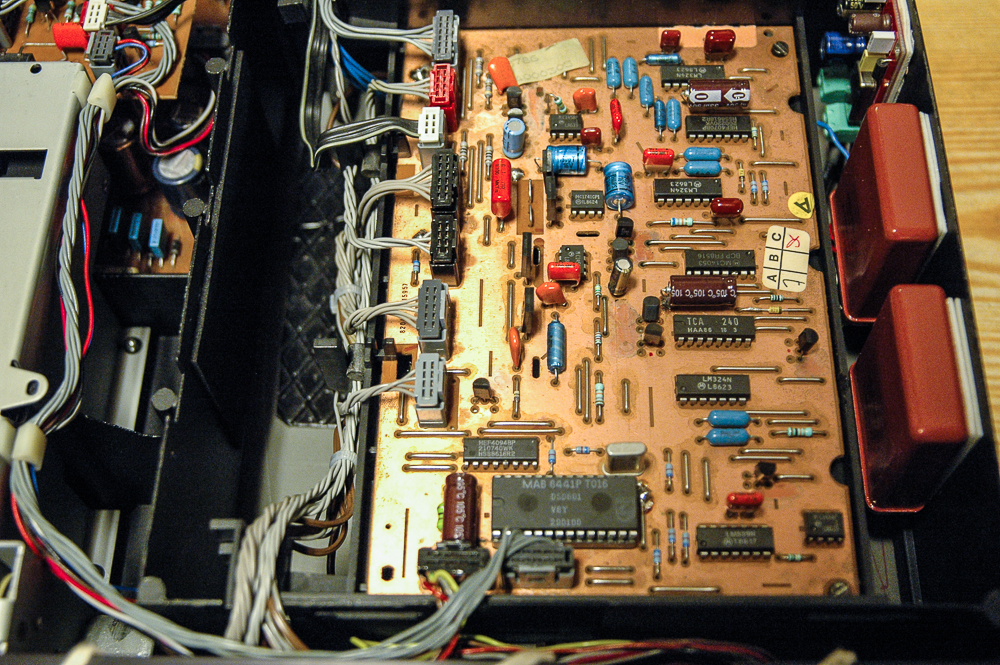
CD 304 mk II top view. Notice the capacitors on the right side, definitely not original!
But now to the interesting comparison between the Mk 0 and the Mk II versions of the CD 304. If I am correct, the differences in DAC technology is the only important difference between the two. So I proceeded by testing these two models against each other several evenings in a row. Usually the Mk II model with the new TDA 1541 DAC is the one that gets recommended in most reviews and articles, but personally I ended up preferring the older Mk 0 model. I felt it to be cleaner and clearer sounding, with a tight and deep bass. Too tight? Too little bloom? Hard to tell, but it certainly had a “vice-like” grip on the bass cones of my loudspeakers. In comparison the Mk II model was slightly more closed-in, with a tad of nasality, and the bass was a little more round and wooly. On the final test evening my friends Helge and Terje happened to visit, and I talked them into assisting me in the listening session in return for something tempting in their glasses. They had no doubt. They both preferred the Mk 0. But let me hasten to add: an evening earlier I had also persuaded another buddy, Johannes, to sit down and listen. He, on the other hand, definitely preferred the Mk II, since this player has a more rounded bass and slightly darker overall tone. He actually plays the bass. But the distinction is not large, and I would have no problem living with either. Stig Inge Bjorge (of Lyra fame), who lives in Japan and assisted me in the proofreading of this article, once told me about the typical international hifi customer: "They claim that they prefer slightly dark and “musical” components, but usually they end up choosing bright and “analytical” sounding equipment”. Had I made the same mistake? I had to think carefully about this. But ultimately I opted for the Mk 0, and I am actually a bit proud that I dared to go against the crowd. (But as I said; the 1540 DAC also has its supporters, so I am not alone). I am trying to think analytically: What was better with the Mk 0? The DAC? Or could it be the fact that it has TWO DACs? Or could there also be some other hidden factor? One can never be completely sure. Remember that these are old products that have been extensively modified. Ultimately, I will be careful to state that one of these DACs is conclusively better than the other. But I will jokingly say that some will prefer the mother, while others will go for the daughter. Each of these two are certainly beauties!
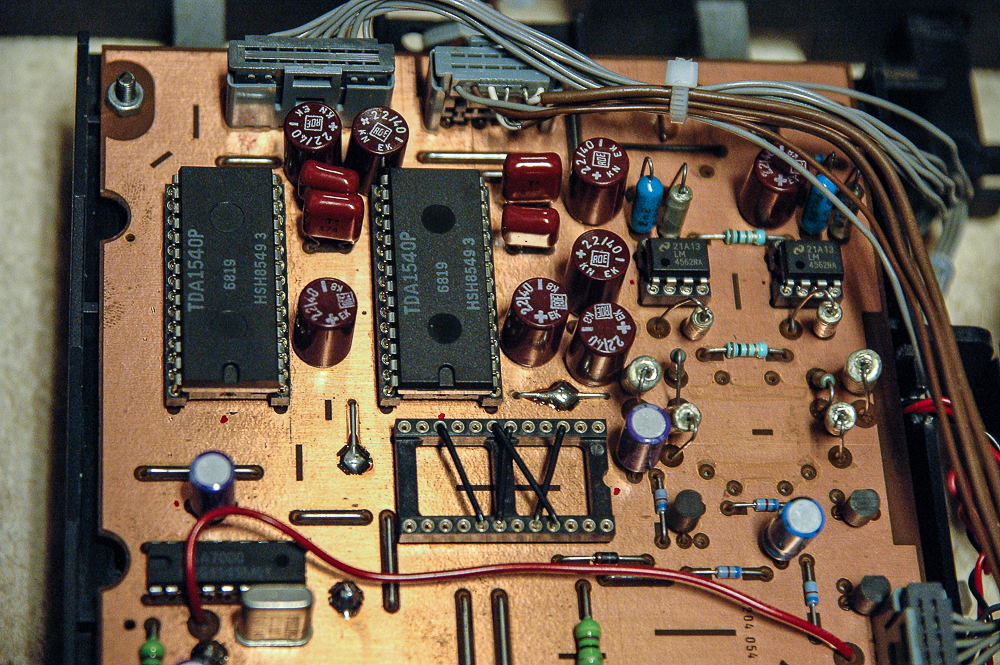 CD 304, bottom view. Two TDA 1540 DACs. Notice the wires bypassing the oversampling!
CD 304, bottom view. Two TDA 1540 DACs. Notice the wires bypassing the oversampling!
The acid test is always: Did I buy the player? Yes I did. The older CD 304 Mk 0 model was less expensive, and I personally preferred its sound, so I opted for that one. I could and should have compared it to lots of other, and newer, CD-players, but who has the time and opportunity to compare with absolutely anything and everything? I can only confirm that this was the best CD player I that I have had in my stereo system at that point in time. Further comparisons belong to the future. Note that many other manufacturers also used Philips technology: Arcam, Meridian, Orelle, Grundig, Revox, B & O, Marantz. Many audiophiles are convinced that earlier Marantz CD players were "improved" Philips models since they were heavier, had better cosmetics, and were more expensive (of course it is true that Philips and Marantz for many years were intertwined in business and used each others assemblies and components). However, I have tried several older Marantz CD-players as well, and it is not my impression that they are necessarily superior. So why not save money and buy a Philips?
Oversampling
This is starting to get complicated, and it`s getting worse. What the heck is oversampling? I have tried to find out, but have not become very much wiser this far. The original Philips DAC, the TDA 1540, was actually a 14-bit DAC while the Japanese competitors quickly introduced 16-bit DACs. Thus Philips lost the specification war. They introduced 4x oversampling to catch up, thus in an elegant way achieving the same resolution (16 bit). But many believe this does nothing to improve the sound, and that it on the contrary will improve the sound if the oversampling gets bypassed. Philips nevertheless gambled on oversampling, and the Japanese manufacturers followed.
Some audiophiles quickly came up with the idea to bypass the oversampling on these excellent sounding TDA 1540 series DACs in order to retrieve the original beauty of sound inherent therein. Both of the CD 304 Mk 0 and Mk II which are the subjects of this article were modified to remove (bypass) the oversampling. I have taken a photo that shows this: A chip is removed and replaced with wires. (The newer chip, the TDA 1541, is 16-bit).
Peter Qvortrup from Audio Note says something interesting about this in Hi-Fi Choice in August 2011, in connection with a review of a complete Audio Note system: "oversampling is a corrective mechanism performing largely the same function in digital circuits that negative feedback does in amplifiers; it improves the measured performance, while significantly degrading the sound quality. This is really obvious when you compare an oversampling DAC to one where the oversampling has been removed. Audio Note realised this back in 1995, and we are surprised that no-one else seems to have noticed. Non-oversampling DACs was used in the early days of CD, but often with aggressive "brickwall" (meaning very sharp/steep) analog filters which can have an even bigger adverse effect on the sound than oversampling." I have no idea how sharp a “brickwall” filter these Philips CD players have. However, since they originally shipped with oversampling, it can be assumed that their analog filters probably were not so sharp. Personally I can only attest that the sound of both these “oversampling-less” CD-players is quite wonderful to my ears!
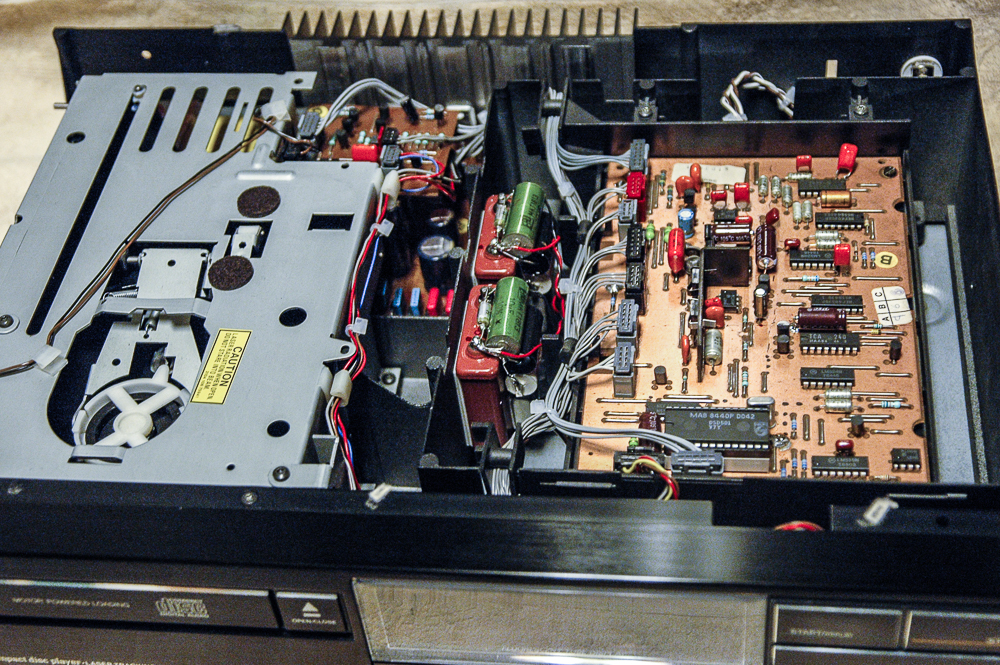
CD 304, top view. Notice the large capacitor glued to the mid-divider. This is definitely not original! Lots of work has been put into these CD players.
In praise of old CD players
In Hi-Fi News January 2007 Paul Miller used this headline in his column "Opinion”. He comments on the results of a test in the previous edition where 3 amplifiers with accompanying CD players were put against each other in a group test. He writes that when the amps and CD players later were tested in isolation it brought things into sharper focus. He stated that the amplifiers sounded much as they have always done, whereas the CD players has become worse, simply because the transports are of the DVD type, and the focus is on up-sampling and over-sampling in complicated algorithms. They are more like a computer than a CD player.
"Do CD players of today really sound substantially better than models that appeared some 15 years ago? Paul Miller suggests not, and reckons it all boils down to silicon." And later: "In many cases the added complexity and manipulation of digital data entertained by up-sampling might outweigh the subjective advantage of a simpler analogue output stage".
I am including this to illustrate that we should not be naïve, believing that everything is improving all the time. Some things are improving, others are getting worse. Paul Miller, who did all the measurements in the test, concluded: “If you ever get the chance to compare some of today's elaborate up-sampling CD players with a truly CD-centric box like Sony`s CDP-715 or an inaugural PDM bitstream model like Rotel`s RCD 965 BX or the Philips CD 850, you will discover that many of the newcomers are not the panacea we have been led to expect”. As usual: Don`t take anything for granted. Listen for yourself, and draw your own conclusions. This is what I personally have tried to do, and what I strive to achieve in my own test methodology. Even though my conclusion is against the mainstream, it is assuring that I receive some expert support.
Is 14 bit enough?
As I googled oversampling, I found an overview of bit resolutions, 10, 12, 14 and 16 bits; with illustrations. Both 10 and 12 bits had obvious steps, and thus evidently too low resolution for music reproduction. 14 bit had a nearly perfect straight line, totally without steps. 16 bit had a ruler straight line. From this one may conclude that even if 14 bits is not perfect, it may very well be sufficient.
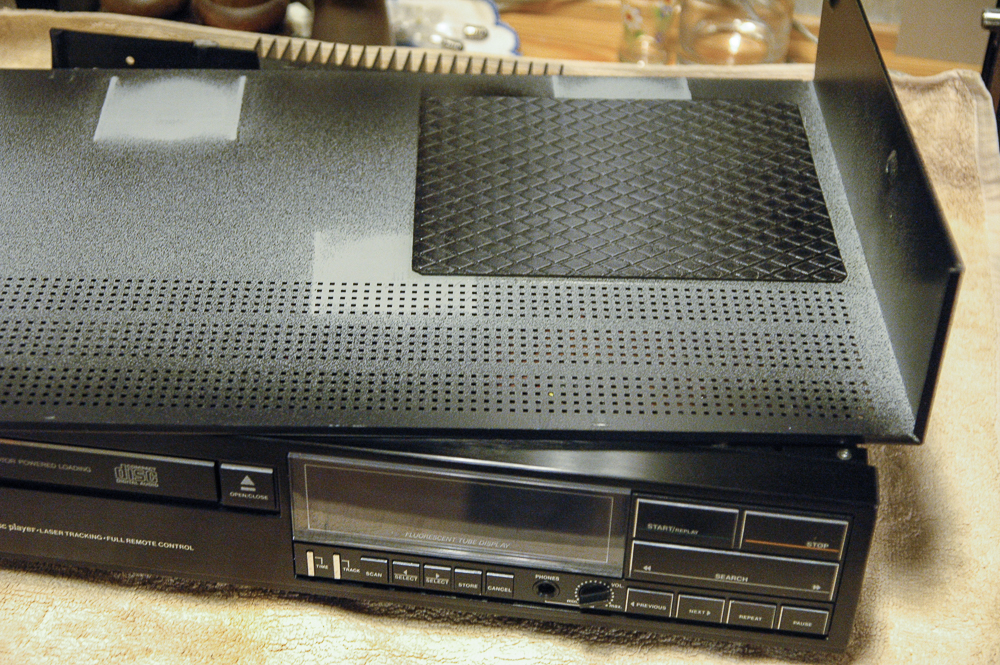 The top and bottom covers are damped with rubber-lead mats on both of the models..
The top and bottom covers are damped with rubber-lead mats on both of the models..
Conclusion
Even though this is an unusual review of a couple of “second hand new” CD players, I am inclined to conclude that these 30 year old CD players are the best to visit my house so far. I look forward to playing CDs every evening, whereas for a long period I have actually mostly been using Spotify and YouTube to discover new and exciting music, or spinning my record player with vinyl discs. But the sound from CD has now elevated above anything I hear from radio, Spotify, and YouTube. And this is despite that I normally consider the sound quality from the Norwegian state broadcasting (NRK) to be really high. I often enjoy their excellent live broadcasts. However the Philips CD players has enhanced the possibilities with CD sound. The sound is surprisingly clear and vivid. Note that I do not necessarily say that my CDs now sound better than vinyl records. Let`s keep that one for later!

